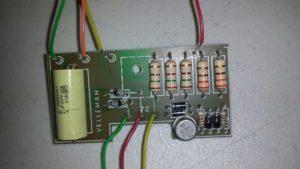A cheap alternative
An ordinary, old-fashioned ignition with dots? Well, a set of points will last 10.000+ km. So what's wrong with that? Because how much do we now drive our classics? But still, the timing and the power of the spark…. Of course you can then buy an electronic ignition and have it installed. But an electronic ignition costs money again. Sometimes even serious money. And money is often a thing.
Now I came across a funny DIY kit from Velleman (k2543), simply via Conrad. Some research and inquiries with friends and acquaintances who knew electronics learned that the entire Velleman thing had been known to them for centuries. And that Velleman nv, is a Belgian wholesaler and electronics developer that has existed for more than 40 years and sells a program of more than 18.000 different products worldwide. So you don't even do business with AliExpress. And my informants, Halbe was not there, all knew that it was and is a good, cheap alternative to an electronic ignition. . So I learned something again. You will get the stuff as a kit and some soldering needs to be done. But then you have something. One of our informants had already made several sets. : “The first took me an hour and a half. Now I can make one in more than two minutes ”. See, that's text!
We found other providers outside of Conrad for similar prices. It will therefore not be much cheaper. Think of a ten or three max. Such a cheap Velleman kit is suitable for engines with two to 8 cylinders. And then it doesn't matter if that block lives under a hood or in a frame. The product has apparently been known for so long that it is clear that contact points - and mount a new set of them right away - just go 50.000 + km.
What does it do?
Normally, the current flows through the contact points to the ignition coils when they open and close, resulting in sparks and burn-in of the points, causing them to wear and to be adjusted regularly. The Vellemankitje is a transistor ignition (transistor is a kind of electronic relay), so with a very small control current you can switch a large current. The contact points remain in place but are only used to switch the transistor.
Advantages, stronger spark and no burn-in of contact points.
The soldering work requires some precision, but the accompanying manual is clear.
Provides a better start and more even running, especially at very high and low speeds.
Only suitable for the minus mass.
Features Velleman Kits K2543:
* Fully resistant to shocks
* Tested in practice on 2-4-6-8 cylinder engines for a total number of km. from 2.500.000.
* Principle: transistor ignition
* Switch element: "Darlington transistor" triple diffused
The ingredients of such a Velleman set are:
* Better start
* Less air pollution
* Lower fuel consumption
* Lower maintenance costs
* Significantly less wear on the breaker, so that the car is constantly optimally adjusted
Specifications Velleman Kits K2543:
* For use with 6 and 12V batteries
* Switching current: 4A
* Typical spark time: 2000µs
* Switching speed: up to 500kHz
* Dimensions print: 70 x 35 mm
You mount with some double-sided tape or a few tie wraps.
And then there's the waterproof G304 housing.
It costs a euro or six and a half
Nice is not it?







Completely agree with Bert, I soldered one for a BMW 3.3 CSI from 1977. With the old conventional circuit, burning in the points was a real drama! After mounting a Velleman kit everything ran smoothly, the BMW was used for autocross and I mounted the printed circuit board in a cast resin casting. When I quit autocross, the set did its job for a few years in a Porsche 924. Points remain almost intact because only a control current flows through. Starting is also better… In the end I gave in to induction and non-contact ignition. greetz fr.
Dolphin,
Don't cheer too early, dots wear in more ways.
Because of the sparks between the points (a bit needed to keep the surface clean), material spatters from one surface to the other (just look at one of them having a pit the other has a peak). then the dots will open less and the time will expire. Do you really want to get rid of the misery then take an electronic ignition with an opto or magnetic sensor, the latter is preferred, can better withstand contamination.
Incidentally, the spark does not get any better, whether you switch the ignition coil current with a switch or with a transistor, the same remains. Primarily, more current will not immediately start running. But otherwise a nice kit has indeed been around for years.
Yes, my late father had already fiddled with a transistor ignition in his Opel Rekord in the 70s.
Jan, not quite true what you write. sparking contact points cause a "slight" shutdown of the ignition coil current. so that the spark plug slowly extinguishes over time. In a transistor or tyristor circuit, this extinction does not take place in time. The result is that the ignition coil energy is displayed in a short time, creating a more powerful spark with a higher energy value. (can even rise to 2 to 3 times the normal value)
Fr.
Bert